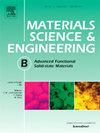制备基于 g-C3N4/MoS2@PPy 复合材料的水性锌离子电池高效阴极
IF 3.9
3区 材料科学
Q2 MATERIALS SCIENCE, MULTIDISCIPLINARY
Materials Science and Engineering B-advanced Functional Solid-state Materials
Pub Date : 2024-09-28
DOI:10.1016/j.mseb.2024.117731
引用次数: 0
摘要
水中的锌离子电池(或 ZIBs)被认为是极有前途的锂离子电池替代品。然而,由于锌离子在正极中的扩散速度缓慢且可逆性差,其商业用途受到了限制。在这里,导电石墨碳片和导电聚吡咯与 MoS2 有效复合(g-C3N4/MoS2@PPy),旨在用作锌离子水电池(AZIBs)的阴极。MoS2 可以均匀地在 PPy 上成核和发展;这可以防止 MoS2 结块,提高活性材料的使用率。g-C3N4/MoS2 材料在加入聚吡咯后呈现出具有花朵状形态的层状纳米片,花朵状形态转变为分层花朵状形态。g-C3N4 的疏松表面含有大量含氧化合物,这一点是可以想象的。与 MoS2 和 g-C3N4/MoS2 相比,g-C3N4/MoS2@PPY 材料的比表面积更高,达到 118.21 m2/g。在 0.1 A g-1 的条件下,g-C3N4/MoS2@PPy 的比容量高达 191.7 mAh g-1。此外,如果电流密度恢复到 0.1 A g-1,比容量可恢复到 186.7 mAh g-1,容量保持率为 96.1%。g-C3N4/MoS2@PPy 在 1.0 A g-1 和 3.0 A g-1 循环 1000 次时,比容量分别为 60 mAh g-1 和 48 mAh g-1,保持率较高。g-C3N4/MoS2@PPy 电极的电化学反应动力学通过循环伏安法(CV)测量和电静电间歇滴定法(GITT)进行了检验。这些方法揭示了电极的低 Zn2+ 扩散能垒和理想的伪电容行为。通过原位表征,阐明了 g-C3N4/MoS2@PPy Zn-闰化过程。本文章由计算机程序翻译,如有差异,请以英文原文为准。
Fabrication of g-C3N4/MoS2@PPy composite based high efficient cathode for aqueous zinc ion battery
Zn-ion batteries in water, or ZIBs, are thought to be extremely promising substitutes for lithium-ion batteries. However, their commercial uses are limited by the sluggish diffusion of zinc ions in the positive electrode and their poor reversibility. Here, conductive graphite carbon sheets and conductive polypyrrole that have been effectively compounded with MoS2 (g-C3N4/MoS2@PPy) are intended to serve as the cathode for aqueous Zinc ion battery (AZIBs). MoS2 may evenly nucleate and develop on the PPy; this prevents MoS2 from clumping together and enhancing active materials’ use. The g-C3N4/MoS2 materials exhibit layered nanosheets with flower-like morphology after polypyrrole incorporation the flower changes to hierarchical flower-like morphology. The quantity of oxygenous compounds on g-C3N4′s loose surface makes this conceivable. The g-C3N4/MoS2@PPy material has a higher specific surface area of 118.21 m2/g compared to MoS2 and g-C3N4/MoS2. The g-C3N4/MoS2@PPy exhibits a high specific capacity of 191.7 mAh g−1 at 0.1 A g−1. Moreover, the specific capacity may return to 186.7 mAh g−1, 96.1 % capacity retention, if the current density is restored to 0.1 A g−1. The g-C3N4/MoS2@PPy maintain a higher specific capacity of 60 and 48 mAh g−1, respectively, at 1.0 and 3.0 A g−1 for 1000 cycles. After 1000 cycles, the g-C3N4/MoS2@PPy show 100 % columbic efficiency. g-C3N4/MoS2@PPy electrode’s electrochemical reaction kinetics were examined using cyclic voltammetry (CV) measurements, and galvanostatic intermittent titration (GITT). These methods revealed the electrode’s low Zn2+ diffusion energy barrier and desirable pseudocapacitive behaviors. The g-C3N4/MoS2@PPy Zn-intercalation process was elucidated using ex-situ characterizations.
求助全文
通过发布文献求助,成功后即可免费获取论文全文。
去求助
来源期刊
CiteScore
5.60
自引率
2.80%
发文量
481
审稿时长
3.5 months
期刊介绍:
The journal provides an international medium for the publication of theoretical and experimental studies and reviews related to the electronic, electrochemical, ionic, magnetic, optical, and biosensing properties of solid state materials in bulk, thin film and particulate forms. Papers dealing with synthesis, processing, characterization, structure, physical properties and computational aspects of nano-crystalline, crystalline, amorphous and glassy forms of ceramics, semiconductors, layered insertion compounds, low-dimensional compounds and systems, fast-ion conductors, polymers and dielectrics are viewed as suitable for publication. Articles focused on nano-structured aspects of these advanced solid-state materials will also be considered suitable.

 求助内容:
求助内容: 应助结果提醒方式:
应助结果提醒方式:


